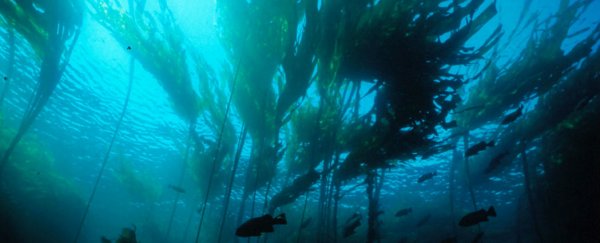The potential of coastal plants and seaweeds to capture carbon and help combat the effects of climate change could be hugely underestimated, Australian researchers say.
Scientists from the University of Technology, Sydney (UTS) and Deakin University have conducted the first investigation into the carbon storage potential of a diverse range of coastal plants and seaweeds, known as macroalgae. These plants naturally capture carbon in their leaves and roots.
Several marine ecosystems, including mangrove forests, seagrass meadows and salt marshes, have the capacity to capture and store what is known as 'blue carbon' from the atmosphere and ocean for long periods of time, mitigating the effect of greenhouse gases.
But the potential for a range of seaweeds to increase this 'blue carbon' stock has been relatively unexplored. Many of the plants examined by the UTS:Science team were thought to break down too rapidly to offer any significant benefits for long-term storage.
But they've shown this isn't always the case, as different plants have different structural properties, meaning some offer greater advantages than others.
They say their results, which were published in the Journal of the Ecological Society of America, could inform future coastal management policies and enable more comprehensive modelling and accounting of 'blue carbon' stocks.
"We wanted to know how… the cell wall structure and cell wall composition of seaweeds and coastal vascular plants like seagrasses, affected their long-term carbon storage potential in blue carbon habitats," lead author and plant biologist Stacey Trevathan-Tackett, from UTS:Science, said in a press release.
"Macroalgae in particular are of interest because they generally produce a lot of biomass and are easily transported making them potential 'donors' to blue carbon stocks."
The UTS:Science team looked at 14 different types of plants, and used a thermal analysis technique to evaluate the conditions and temperatures under which the plant tissue began to decompose, and release carbon.
"We assessed the structural complexity of multiple lineages of plant and tissue types with differing cell-wall structures and found that decomposition dynamics varied significantly according to differences in cell wall structure and composition among taxonomic groups and tissue function," the team wrote in their paper.
They say that for seaweed, cell wall structure and composition are important indicators of the long-term carbon storage potential.
In addition, they discovered that certain species of seaweed contained compounds that only degraded at very high temperatures. The ability to retain these compounds is a factor in their ability to store carbon for longer periods.
"Until now, seaweeds have been thought to break down rapidly and therefore not be significant contributors to long-term carbon sequestration," environmental scientist and team member, Alecia Bellgrove from Deakin University, said in the release.
"However, what we have shown is that not all seaweeds are equal and some show great potential for long-term sequestration. There is enormous macroalgal biomass in our oceans and understanding where that all ends up and how much of it is locked away is the next big area of research to pursue," she said.
While capturing and storing carbon in our oceans is hugely important, many of the ecosystems that fulfill this function are under threat. According to the UNESCO supported Blue Carbon Initiative, upwards of 9,800 square kilometres of mangroves, seagrasses and salt marshes are destroyed each year.
Hopefully this trend can reverse, given the utility of these ecosystems in the fight against climate change. Earlier this month, Sri Lanka became the first country to comprehensively protect all of its mangrove forests.
Love science? Find out more about the research happening at UTS:Science.
